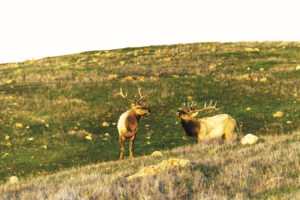As we report in The Checkerspot Comes Home, Coyote Ridge southeast of San Jose is one of the last refuges for the endangered bay checkerspot butterfly. A good deal of that habitat is protected, but the checkerspots here should keep their antennae tuned to unfolding events in the neighboring Coyote Valley.
Since 2002, the city of San Jose has been working on a long-term strategy for this 7,000 acre swath of undeveloped land. The Coyote Valley Specific Plan encountered an unexpected setback on August 1, 2007, when Dan Horwedel, San Jose’s director of planning, building, and code enforcement, determined that the draft Environmental Impact Report (EIR) for the planned development needed to be extensively revised.
The determination came in response to an unprecedented 1,300 pages of responses, many of them scathingly critical, from environmental groups and government agencies at all levels. Many, including the federal Fish and Wildlife Service and California Department of Fish and Game, criticized the draft EIR for underestimating or failing to take into account a number of potential impacts, ranging from water use to greenhouse gas emissions to the potential effects on threatened and endangered species, including the bay checkerspot.
As currently conceived, the plan would divide Coyote Valley into three sections. The northwestern section, closest to the present-day limits of San Jose, would be zoned for industrial campuses. The central area would be a dense, mixed-use urban zone. The remaining 3,600 acres, though they include some of the most developed areas today, would be designated as a semi-rural “greenbelt,” designed to encourage small-scale agriculture. This plan lost one of its most influential supporters in January with the departure of Mayor Ron Gonzales. Chuck Reed, the current mayor, has advocated a slower approach to development of the valley, resisting calls by some on the city council to amend a regulation forbidding construction of new residences before a minimum threshold of jobs exist in the area.
This regulatory trigger, designed to reduce long commutes by Coyote Valley residents, underlines another difficulty of creating a major new population center on the fringes of the urban core. Though the Specific Plan aims to create a community centered around mass transit and pedestrian corridors, it still foresees a quarter of a million automobile trips per day generated by 80,000 prospective residents. Given its proximity to Coyote Ridge, such a new mass of humanity threatens local bay checkerspots with the same “drive-by extinction” through nitrogen deposition that eradicated the Edgewood population. Though the revision of the draft EIR will not be completed until at least the middle of 2008, and development of the Specific Plan may be pushed back even more significantly, momentum seems overwhelmingly on the side of the eventual development of a significant portion of Coyote Valley.
There is a ray of hope for the bay checkerspots, however. The federal Fish and Wildlife Service recently proposed declaration of critical checkerspot habitat on nearly 20,000 acres of serpentine soils in San Mateo and Santa Clara counties, including Edgewood Park and the length of Coyote Ridge. Such a designation would require any federal agency funding or permitting activities in the area to consult with Fish and Wildlife and prevent damage to the habitat. While it would not have a binding effect on the ongoing revision to the Coyote Valley draft EIR, such designations are often taken into account in the planning process. Public comments for the critical habitat proposal will be accepted until October 20. Email to express your views.
For more information on the ongoing planning process, visit the website of the city of San Jose.




